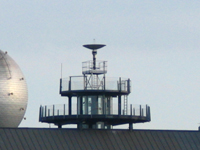|
Remote
sensing releated research at the
Eötvös Loránd University based on data provided by the ELTE receiving station |
||||||
|
Home
|
||||||
|
In 2002, the Space Research Group (SRG) of the Eötvös Loránd University (ELTE) established a satellite receiving station in Budapest, Hungary. This station currently receives Earth observation data from polar orbiting meteorological and Earth observing satellites, i.e., the data of the American National Oceanic and Atmospheric Administration (NOAA) series, and the Moderate Resolution Imaging Spectroradiometer (MODIS) data from satellites Terra and Aqua.
Polar orbiting environmental satellites are transmitting invaluable information about the state of the atmosphere, land, and ocean surface with high spatial and temporal resolution. The main advantage of the direct broadcast satellite receiving stations is that they receive this kind of data in real-time, and therefore, we are able to utilize the retrieved information near real-time without any time lag caused by official data-processing. The HRPT data stream, which is the direct broadcast of the NOAA satellites, contains data of several radiometers, such as the Advanced Very High Resolution Radiometer (AVHRR) or ATOVS (a group of sounding instruments). MODIS is also a scanning radiometer with 36 spectral bands between 0.645 and 14.235 micrometer. |
| Back |
The website was designed and it is maintained by: Kern Anikó
Copyright (C) ELTE


